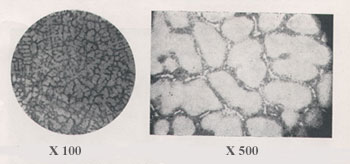Microscopic view of Palador structure

|
|
excellent stability in oral
cavity, not connecting to oxygen from the air, not changing the
color and toughness enough to sustain all the articulatory forces
in mouth. Helped by state ruled economy, price of Palador, during
the life of former Yugoslavia was very low - up to 1,5 Euros for
a gram of Palador . Two grams of palador were needed for creation
of a single crown .So, alloy expenses for one crown were 3 euros,
a great price, concerning the total expenses .
|
|
Total material
expenses for one crown were 7 euros . This is the upper limit
in order to keep the final Macedonian price of a composite crown
to 25-30 euros. Thirty Euros is a very small amount of money for
one composite crown (concidering the World prices ), but that
is the most that dentist could take out of the patient`s pocket
due to pore financial situation in Macedonia . If we rise the
expenses for materials (including alloys) , we will rise the final
price of a crown , and we will not be profitable on the dental
market . And that was what happened, what pulled PALADOR out of
Macedonian dental market - INCREASE IN PRICE !! After the fall
of Yugoslavian federation, a state based economy collapsed, and
we all turned into a free market. There were no more state interventions
and a lot of dental materials showed their true prices and they
became not suitable for many dentists and dental technicians.The
price of Palador was risen up from 1,5 euros per gram at the first
wave into 3 and after a while the second lethal wave came and
the price rised up to unbelievable 9 euros per gram !! Macedonian
dentists and dental technicians had to adapt to the new situation
and to find less expensive alloys . The only answer was : non-precious
alloys, alloys based on Nickel and Chromium, the same ones used
as metal base for porcelain crowns. Less quality, but less expensiv
. Price of Nickel-Chromium alloys is very adequate for Macedonian
dental needs . One gram of this non-precious alloy is only 20
cents (One fifth of an Euro) , so we will spend 40 cents for fabrication
of a metal coping for a single crown. Forty cents comparing to
Palador`s 9 euros is a big difference. This changes occurred in
90`s , since the beginning of Macedonia`s independence . After
the first contact these non-precious alloys turned to be more
qualitative in some points comparing to Palador - harder , more
resistant to corrosion and color change . Hardiness (due to Carbon)
is giving technicians a liberty do create even thinner base profiles
and bigger surface reduction (on the contact areas between abutments
and pontics) so that could be more space for composite or porcelain
material and more maneuvering space for a technician to create
a state of art dental restorations.So today knowing that ceramic
products are taking over the market , and due to financial situation
in Macedonia , with a big confidence we can say that Palador is
a history .
|


